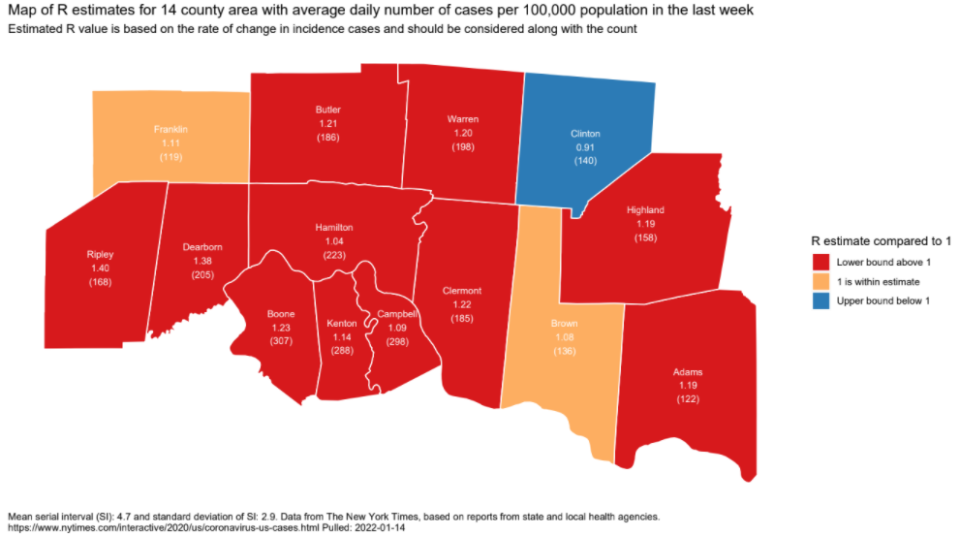COVID-19: It's unclear if cases have peaked, but Cincinnati's hospitals are in a crunch
Friday's data from the Cincinnati region's hospitals paints a grim picture of how they're facing an influx of patients battling COVID-19 and the unprecedented stress it's putting on their systems.
The number of patients currently hospitalized with COVID-19 rose to 1,006 as of Friday morning, according to Tiffany Mattingly, vice president of clinical strategies for the Health Collaborative, the coordinating group for the region's 40 hospitals. As of Friday, 188 patients are in ICU beds and 150 are on ventilators.
COVID-19 surge: Half of region's schools close or remote Friday
Omicron: How its symptoms differ from a cold or the flu
All regional counties remain higher than the highest Centers for Disease Control and Prevention classification for total new cases and for the percentage of positive tests.
"We are not yet certain if our region has peaked," a note on the Health Collaborative Situational Dashboard said Friday.
The pandemic peak of filled ICU beds came on Dec. 30, 2020, when 203 patients were in the ICU. And the number of people currently on ventilators falls eight short of the 2021 high of 158 that took place on Jan. 5, 2021.
On Friday evening, the Health Collaborative announced that most hospital systems were updating their visitor restrictions to keep patients and residents safe. Cincinnati Children's Hospital Medical Center was the exception.
While the Health Collaborative asked people to check individual hospitals' rules, it provided these rules for adult hospitals:
All visitors must wear masks at all times while on-premises.
Adult patients are limited to one visitor at a time.
No visitors under age 16.
Visitors who have any respiratory illness symptoms (coughing, sneezing, runny nose, fever, etc.) may not see patients.
Visitors are not permitted if they have traveled internationally within the past 14 days
The region's hospitals also have adopted the Centers for Disease Control and Prevention guidelines for healthcare workers returning to work, the Health Collaborative said.
Earlier this week, Christ Hospital president and chief executive officer Deborah Hayes detailed how hospitals are monitoring capacity and making fluid decisions about how much they need to limit elective inpatient surgeries to meet demands. They're also expanding the number of patients individual nurses and physicians are looking after, increasing a normal load of one to two patients per nurse or physician to three or four patients per health worker in some cases.
"We are at a critical point," Hayes said during Hamilton County's weekly COVID-19 briefing Wednesday, emphasizing the region hasn't even faced its peak of the winter surge yet. "We need the community's help at this time, because unlike other businesses who are certainly under tremendous stress as well because of staffing or because of a number of illnesses, we cannot shut our doors, nor will we shut our doors."
The limits on elective surgeries came as the region faces a record-setting number of cases in Hamilton, Butler, Clermont and Warren counties.
The surge in cases is likely due to the more contagious but less dangerous omicron variant of the novel coronavirus.
The number of new cases per 100,000 residents, as measured by a seven-day moving average, hit new records in Butler, Clermont and Warren counties Thursday and remained near records in Hamilton, Boone, Campbell and Kenton counties.
Mattingly said the Health Collaborative is monitoring closely what's going on in northern Ohio, particularly the Cleveland area where hospitalizations climbed for another two weeks after hitting their peak in cases.
"We're watching Cleveland closely to help project when we may see a peak in our hospitalizations," she said. "And of course watching the cases closely to see if we're identifying any plateau in our case number."
The good news, Mattingly said, is that other regions have shown quick declines just as they underwent quick inclines. In other words, because omicron spreads so quickly, other cities have seen its plateau happen quickly as well.
"As quickly as they (Cleveland) climbed, they then quickly started a decline," she said. "Almost like there was no more kindling left, there was no one left for this virus to affect and it started to slow down."
What's happening with infections?
The rate at which the novel coronavirus is reproducing locally indicates there is community spread of the contagion.
The situational dashboard reports the R naught, a value that measures spread, for the region and individual areas of it for the last seven days. Last Wednesday's reading for the region was 1.03, according to the Health Collaborative Situational Dashboard. In Hamilton County, it was 1.16. Any reading over 1 indicates community spread of the virus.

What's the local toll since the COVID pandemic started?
A total of 4,641 residents of the 16-county region have been reported as dying of COVID-19, an Enquirer analysis shows. A total of 429,571 cases of the illness have been reported. That number may not reflect the full picture because some people have had the disease more than once – and an untold number of infections aren't in the total because they were discovered by people using in-home tests and were not reported to health officials.
What should the residents in the region do?
The Health Collaborative released this list of recommendations for the public:
Get vaccinated. Get your booster shot when eligible.
Practice social distancing.
Wear a mask even if you’re vaccinated.
Clean hands frequently with soap and water, for at least 20 seconds each time.
Stay home from work, school or other activities if you feel ill.
Test if you have symptoms that could be COVID-19 to prevent spread.
Use testing sites at pharmacies, urgent care centers or locally hosted sites found at Test and Protect Cincy, the Health Collaborative's site that lists free testing locations.
This article originally appeared on Cincinnati Enquirer: Ohio Covid-19: Hospitals stressed as surge continues in region

